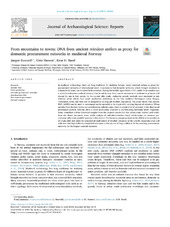| dc.contributor.author | Rosvold, Jørgen | |
| dc.contributor.author | Hansen, Gitte | |
| dc.contributor.author | Røed, Knut | |
| dc.date.accessioned | 2019-08-14T08:52:06Z | |
| dc.date.available | 2019-08-14T08:52:06Z | |
| dc.date.issued | 2019-08 | |
| dc.Published | Rosvold J, Hansen G, Røed KH. From mountains to towns: DNA from ancient reindeer antlers as proxy for domestic procurement networks in medieval Norway. Journal of Archaeological Science: Reports. 2019;26:101860 | eng |
| dc.identifier.issn | 2352-409X | |
| dc.identifier.issn | 2352-4103 | |
| dc.identifier.uri | https://hdl.handle.net/1956/20664 | |
| dc.description.abstract | In medieval archaeology there are long traditions for studying foreign, exotic material culture as proxy for procurement networks of international reach. A paradox is that domestic networks, which brought products to consumers at home, has attracted little attention. During the Middle Ages (1030–1537), antler from reindeer was a north Scandinavian outland resource that found its way from remote mountains to settlements at home and abroad for use in hair combs. In the current pilot study, molecular genetic methods were employed to test whether antler debris from comb production workshops in the four medieval Norwegian towns Bergen, Trondheim, Skien and Oslo can be assigned to its original reindeer population. The study shows that ancient DNA (aDNA) can be used to provenance antler material to its origin with varying degrees of certainty: When samples from the four towns are considered as collective units, there is a high level of certainty in the discovered provenance pattern, whereas there is more uncertainty attached to provenancing individual antler fragments. Some immediate culture historical insights from the project's results are that urban comb makers used antler from the closest mountain areas, while analysis of individual-reindeer-based relationships on resource procurement adds some possible nuances to this picture. Furthermore, assigning dated antler debris to its population of origin adds new dates for commercial exploitation of reindeer resources in the specific mountain areas and adds new and high-definition empirical substance to the picture of long traditions for far-reaching procurement networks for Norwegian outland resources. | en_US |
| dc.language.iso | eng | eng |
| dc.publisher | Elsevier | eng |
| dc.relation.uri | https://www.sciencedirect.com/science/article/pii/S2352409X18307867 | |
| dc.rights | Attribution-Non Commercial-No Derivatives CC BY-NC-ND | eng |
| dc.rights.uri | http://creativecommons.org/licenses/by-nc-nd/4.0/ | eng |
| dc.subject | Ancient DNA | eng |
| dc.subject | Comb production | eng |
| dc.subject | Domestic procurement networks | eng |
| dc.subject | Mitochondrial DNA | eng |
| dc.subject | Raw material provenance | eng |
| dc.subject | Outland resources | eng |
| dc.title | From mountains to towns: DNA from ancient reindeer antlers as proxy for domestic procurement networks in medieval Norway | eng |
| dc.type | Peer reviewed | en_US |
| dc.type | Journal article | en_US |
| dc.date.updated | 2019-06-13T13:17:55Z | |
| dc.description.version | publishedVersion | |
| dc.rights.holder | Copyright 2019 The Authors | eng |
| dc.identifier.doi | https://doi.org/10.1016/j.jasrep.2019.05.025 | |
| dc.identifier.cristin | 1703251 | |
| dc.source.journal | Journal of Archaeological Science: Reports | |

